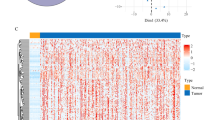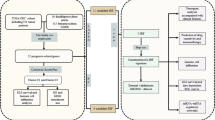Abstract
Hepatocellular carcinoma (HCC) ranks as the second leading cause of cancer-related deaths globally. Disulfidptosis is a newly identified form of regulated cell death that is induced by glucose starvation. However, the clinical prognostic characteristics of disulfidptosis-associated genes in HCC remain poorly understood. We conducted an analysis of the single-cell datasets GSE149614 and performed weighted co-expression network analysis (WGCNA) on the Cancer Genome Atlas (TCGA) datasets to identify the genes related to disulfidptosis. A prognostic model was constructed using univariate COX and Lasso regression. Survival analysis, immune microenvironment analysis, and mutation analysis were performed. Additionally, a nomogram associated with disulfidptosis-related signature was constructed to identify the prognosis of HCC patients. Patients with HCC in the TCGA and GSE14520 datasets were categorized using a disulfidptosis-related model, revealing significant differences in survival times between the high- and low-disulfidptosis groups. High-disulfidptosis patients exhibited increased expression of immune checkpoint-related genes, implying that immunotherapy and certain chemotherapies may be beneficial for them. Meanwhile, the ROC and decision curves analysis (DCA) indicated that the nomogram has satisfying prognostic efficacy. Moreover, the experimental results of GATM in this prognostic model indicated that GATM is low expressed in HCC tissues, and GATM knockdown promotes the proliferation and migration of HCC cells. By analyzing single-cell and bulk multi-omics sequencing data, we developed a prognostic signature related to disulfidptosis and explored the relationship between high- and low-disulfidptosis groups in HCC. This study offers a novel reference for gaining a deeper understanding of the role of disulfidptosis in HCC.









Similar content being viewed by others
Data availability
This study analyzed publicly available datasets. The data were derived from TCGA-LIHC database, and the GSE149614 and GSE14520 in the GEO database, respectively.
References
Villanueva A (2019) Hepatocellular carcinoma. N Engl J Med 380(15):1450–1462
Llovet JM et al (2016) Hepatocellular carcinoma. Nat Rev Dis Primers 2:16018
Siegel RL et al (2023) Cancer statistics, 2023. CA Cancer J Clin 73(1):17–48
Liu X et al (2023) Actin cytoskeleton vulnerability to disulfide stress mediates disulfidptosis. Nat Cell Biol 25(3):404–414
Li Y et al (2023) Identification of disulfidptosis-related subtypes, characterization of tumor microenvironment infiltration, and development of a prognosis model in colorectal cancer. J Cancer Res Clin Oncol 149(15):13995–14014
Huang J et al (2023) Identification of a disulfidptosis-related genes signature for prognostic implication in lung adenocarcinoma. Comput Biol Med 165:107402
Chen H et al (2023) Leveraging a disulfidptosis-based signature to improve the survival and drug sensitivity of bladder cancer patients. Front Immunol 14:1198878
Yang L et al (2023) Based on disulfidptosis, revealing the prognostic and immunological characteristics of renal cell carcinoma with tumor thrombus of vena cava and identifying potential therapeutic target AJAP1. J Cancer Res Clin Oncol 149(12):9787–9804
Zhao S et al (2023) Crosstalk of disulfidptosis-related subtypes, establishment of a prognostic signature and immune infiltration characteristics in bladder cancer based on a machine learning survival framework. Front Endocrinol (Lausanne) 14:1180404
Xu K et al (2023) Identification of disulfidptosis related subtypes, characterization of tumor microenvironment infiltration, and development of DRG prognostic prediction model in RCC, in which MSH3 is a key gene during disulfidptosis. Front Immunol 14:1205250
Zheng T et al (2023) Disulfidptosis: a new form of programmed cell death. J Exp Clin Cancer Res 42(1):137
Meng Y, Chen X, Deng G (2023) Disulfidptosis: a new form of regulated cell death for cancer treatment. Mol Biomed 4(1):18
Liu X, Zhuang L, Gan B (2023) Disulfidptosis: disulfide stress-induced cell death. Trends Cell Biol 34(4):327–337
Chen S et al (2023) Corrigendum: application of single-cell sequencing to the research of tumor microenvironment. Front Immunol 14:1345222
Fan J, Slowikowski K, Zhang F (2020) Single-cell transcriptomics in cancer: computational challenges and opportunities. Exp Mol Med 52(9):1452–1465
Langfelder P, Horvath S (2008) WGCNA: an R package for weighted correlation network analysis. BMC Bioinformatics 9:559
Xiang J et al (2021) Gluconeogenic enzyme PCK1 deficiency promotes CHK2 O-GlcNAcylation and hepatocellular carcinoma growth upon glucose deprivation. J Clin Invest 131(8):e144703
Gou D et al (2023) Gluconeogenic enzyme PCK1 supports S-adenosylmethionine biosynthesis and promotes H3K9me3 modification to suppress hepatocellular carcinoma progression. J Clin Invest 133(13):e161713
Liu MX et al (2018) Metabolic reprogramming by PCK1 promotes TCA cataplerosis, oxidative stress and apoptosis in liver cancer cells and suppresses hepatocellular carcinoma. Oncogene 37(12):1637–1653
Liu R et al (2021) O-GlcNAc modified-TIP60/KAT5 is required for PCK1 deficiency-induced HCC metastasis. Oncogene 40(50):6707–6719
Huang H et al (2022) Identification of the level of exosomal protein by parallel reaction monitoring technology in HCC patients. Int J Gen Med 15:7831–7842
Yao S et al (2021) ALDH2 is a prognostic biomarker and related with immune infiltrates in HCC. Am J Cancer Res 11(11):5319–5337
Seo W et al (2019) ALDH2 deficiency promotes alcohol-associated liver cancer by activating oncogenic pathways via oxidized DNA-enriched extracellular vesicles. J Hepatol 71(5):1000–1011
Mustafa MG et al (2013) Biomarker discovery for early detection of hepatocellular carcinoma in hepatitis C-infected patients. Mol Cell Proteomics 12(12):3640–3652
Wang Y et al (2023) Impact of apolipoprotein A1 on tumor immune microenvironment, clinical prognosis and genomic landscape in hepatocellular carcinoma. Precis Clin Med 6(3):pbad021
Yuan W et al (2021) Transcriptomic characterization reveals prognostic molecular signatures of sorafenib resistance in hepatocellular carcinoma. Aging (Albany NY) 13(3):3969–3993
Shi Y et al (2024) Protein-centric omics analysis reveals circulating complements linked to non-viral liver diseases as potential therapeutic targets. Clin Mol Hepatol 30(1):80–97
Asif S et al (2022) Hmgcs2-mediated ketogenesis modulates high-fat diet-induced hepatosteatosis. Mol Metab 61:101494
Liu F et al (2023) A demonstration based on multi-omics transcriptome sequencing data revealed disulfidptosis heterogeneity within the tumor microenvironment of esophageal squamous cell carcinoma. Discov Oncol 14(1):96
Chen P, Shen J (2023) A disulfidptosis-related gene signature associated with prognosis and immune cell infiltration in osteosarcoma. Bioengineering (Basel) 10(10):1121
Xin S et al (2023) A novel model based on disulfidptosis-related genes to predict prognosis and therapy of bladder urothelial carcinoma. J Cancer Res Clin Oncol 149(15):13925–13942
Li R et al (2024) Targeted regulated cell death with small molecule compounds in colorectal cancer: current perspectives of targeted therapy and molecular mechanisms. Eur J Med Chem 265:116040
Zhao J et al (2023) Disulfidptosis-related signatures for prognostic and immunotherapy reactivity evaluation in hepatocellular carcinoma. Eur J Med Res 28(1):571
Zhang C et al (2024) Development and experimental validation of a machine learning-based disulfidptosis-related ferroptosis score for hepatocellular carcinoma. Apoptosis 29(1–2):103–120
Yang T et al (2023) Integrative analysis of disulfidptosis and immune microenvironment in hepatocellular carcinoma: a putative model and immunotherapeutic strategies. Front Immunol 14:1294677
Yang L, Zhang W, Yan Y (2023) Identification and characterization of a novel molecular classification based on disulfidptosis-related genes to predict prognosis and immunotherapy efficacy in hepatocellular carcinoma. Aging (Albany NY) 15(13):6135–6151
Xu L et al (2024) Integrating bioinformatics and experimental validation to unveil disulfidptosis-related lncRNAs as prognostic biomarker and therapeutic target in hepatocellular carcinoma. Cancer Cell Int 24(1):30
Wang Z et al (2023) Based on disulfidptosis-related glycolytic genes to construct a signature for predicting prognosis and immune infiltration analysis of hepatocellular carcinoma. Front Immunol 14:1204338
Chen X, Liang Q, Zhou Y (2023) Construction of a novel disulfidptosis-related signature for improving outcomes in hepatocellular carcinoma: observational study. Medicine (Baltimore) 102(40):e35423
Wang T et al (2023) Disulfidptosis classification of hepatocellular carcinoma reveals correlation with clinical prognosis and immune profile. Int Immunopharmacol 120:110368
Wei Q et al (2023) Disulfidptosis-associated lncRNAs are potential biomarkers for predicting immune response and prognosis within individuals diagnosed with hepatocellular carcinoma. Hepat Med 15:249–264
Qu J et al (2024) Molecular subtypes of disulfidptosis-regulated genes and prognosis models for predicting prognosis, tumor microenvironment infiltration, and therapeutic response in hepatocellular carcinoma. Int J Biol Macromol 261(Pt 1):129584
Tang J et al (2024) Disulfidptosis-related signature predicts prognosis and characterizes the immune microenvironment in hepatocellular carcinoma. Cancer Cell Int 24(1):19
Li XM et al (2023) Identification of disulfidptosis-related genes with immune infiltration in hepatocellular carcinoma. Heliyon 9(8):e18436
Chen Y et al (2023) A novel disulfidptosis-related immune checkpoint genes signature: forecasting the prognosis of hepatocellular carcinoma. J Cancer Res Clin Oncol 149(14):12843–12854
Ni L et al (2023) Development of the RF-GSEA method for identifying disulfidptosis-related genes and application in hepatocellular carcinoma. Curr Issues Mol Biol 45(12):9450–9470
Jia X et al (2023) Constructed risk prognosis model associated with disulfidptosis lncRNAs in HCC. Int J Mol Sci 24(24):17626
Xu K et al (2024) Disulfidptosis-related lncRNA signatures assess immune microenvironment and drug sensitivity in hepatocellular carcinoma. Comput Biol Med 169:107930
Guo Z et al (2024) A novel disulfidptosis-related lncRNAs signature for predicting survival and immune response in hepatocellular carcinoma. Aging (Albany NY) 16(1):267–284
Acknowledgements
Thanks to TCGA and GEO databases and uploaders of the dataset.
Funding
This research was supported by the National Natural Science Foundation of China (No.82102512).
Author information
Authors and Affiliations
Contributions
Zelin Tian: Conceptualization (equal); Data curation (equal); Investigation (equal); Methodology (equal); Validation (equal); Visualization (equal); Writing-original draft (equal); Writing-review & editing (equal). Junbo Song: Conceptualization (equal); Data curation (equal); Investigation (equal); Methodology (equal); Validation (equal). Jiang She: Data curation (equal); Investigation (equal); Validation (equal); Visualization (equal). Weixiang He: Project administration (equal); Supervision (equal); Validation (equal). Shanshan Guo: Methodology (equal); Supervision (equal); Validation (equal); Resources (equal); Funding acquisition (equal); Writing-review & editing (equal). Bingchen Dong: Conceptualization (equal); Project administration (equal); Resources (equal); Supervision (equal); Writing-review & editing (equal).
Corresponding author
Ethics declarations
Ethical approval
The studies involving humans were approved by the Ethics Committee in Xijing Hospital of Air Force Medical University. The studies were conducted in accordance with the local legislation and institutional requirements. The participants provided their written informed consent to participate in this study.
Competing interest
The authors declare no competing interests.
Additional information
Publisher's Note
Springer Nature remains neutral with regard to jurisdictional claims in published maps and institutional affiliations.
Supplementary Information
Below is the link to the electronic supplementary material.
10495_2024_1968_MOESM2_ESM.tif
Supplementary file2. Figure S1 A heat map was generated to display the infiltration of immune cells in both the high disulfidptosis group and the low disulfidptosis group (TIF 15.2 MB)
10495_2024_1968_MOESM3_ESM.tif
Supplementary file3. HMGCS2, CFHR2, CFB, ALDH2, GATM, TTR and PCK1 were down-regulated in HCC tissues from the HPA database. (A)HMGCS2, Antibody HPA027442; (B)CFHR2, Antibody HPA038915; (C)CFB, Antibody HPA001817; (D)APOA1, Antibody HPA046715; (E)ALDH2, Antibody HPA051065; (F)GATM, Antibody HPA026077; (G)TTR, Antibody CAB002517; (H)PCK1, Antibody HPA006277 (TIF 26.3 MB)
Rights and permissions
Springer Nature or its licensor (e.g. a society or other partner) holds exclusive rights to this article under a publishing agreement with the author(s) or other rightsholder(s); author self-archiving of the accepted manuscript version of this article is solely governed by the terms of such publishing agreement and applicable law.
About this article
Cite this article
Tian, Z., Song, J., She, J. et al. Constructing a disulfidptosis-related prognostic signature of hepatocellular carcinoma based on single-cell sequencing and weighted co-expression network analysis. Apoptosis (2024). https://doi.org/10.1007/s10495-024-01968-z
Accepted:
Published:
DOI: https://doi.org/10.1007/s10495-024-01968-z




